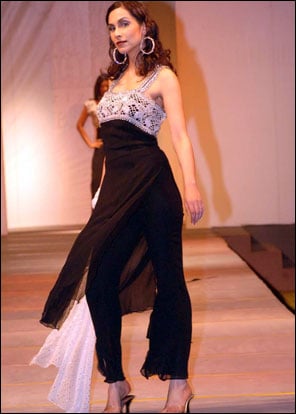|
|
| |
Flash
FASHION UPDATE
|
| |
Be
Pakistani, buy Pakistani
For 60 years, we've been a sponge, soaking up every trend coming our
way, be it the floral printed tight teddies of the '60s that were
inspired by Woodstock or the army jackets that came in with the military
sweep last year. We have adapted from the Middle East, India as well
as Central Asia and the result is a very interesting blend of cultures.
But we have also managed to give each adaptation a twist of our own,
the Pakistani seal of approval! Here's Pakistan's style identity at
a glance:
Me and my shalwar
No one cuts a shalwar as well as a Pakistani tailor and no one wears
it as stylishly as the babes in our urban centres. Though the garment
does take inspiration from Persia and Turkey, it has become an inseparable
part of being Pakistani. Designers like Maheen and Nomi Ansari have
pumped it with volume: dhoti shalwar, patiala shalwar and the cowl
shalwar have all seen times of glory and continue to influence the
girls in Lahore. They are still being worn with short shirts and flats
creating a pumped up, oversized look. Other designers like Sana Safinaz,
Iman Ahmad (Body Focus) and Sonya Battla have slimmed down the silhouette
to the trousers and capris that inspire Karachi's working women. Elegant
and practical in shape they get a thumbs up from the south. But even
in its most basic form, the shalwar remains indigenous to Pakistan
and is worn by a whopping 80 per cent of Pakistanis nationwide. If
you travel in jeans, you'll be asked if you're Indian. If you're in
a shalwar, the world will know you're Pakistani!
|
 |
| |
Fairy
tales live on in khussas
Aladdin wears them, sultans have worn them and to date, all traditional
grooms in Pakistan wear them. The milk man wears them, as do all villagers.
Khussas make a style statement of their own, classifying social status
and occasion too. In Punjab, the bigger the moonch on the khussa,
the more power it symbolizes. In Karachi the Urdu speaking rich go
for the kid leather variety that is so soft it can roll up like a
sponge without cracking. Women go for bright coloured and embellished
khussas to match their ensembles. Khussas are to Pakistan what clogs
are to the Dutch.
The sun sets in the west
There was a time when the sari was the most popular choice for evening
wear but that has changed over the years. Now the evening look is
getting increasingly westernized. That doesn't mean people are wearing
cocktail dresses and ball gowns (though increasing sightings of those
are being witnessed too) but dressing up has changed. The young prefer
slinky, sexy tops over jeans and men continue as they always have:
in jackets and suits. Even those who are not so modern are inclined
to bring in some western element in their wardrobe. |
 |
| |
|

